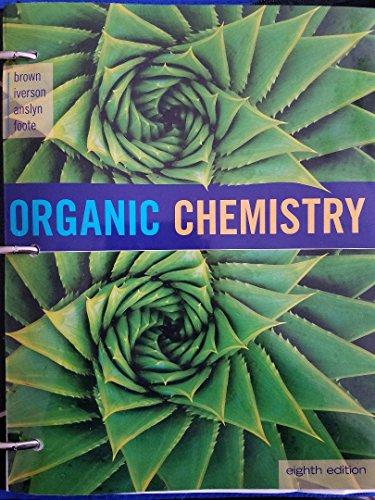
(a)
Interpretation:
Whether the given statement is true or false has to be checked and also explanation has to be given.
Concept Introduction:
Chiral center:
A tetrahedral atom that is bonded to four different groups is called as chiral center. The most commonly known tetrahedral atom is carbon.
(b)
Interpretation:
Whether the given statement is true or false has to be checked and also explanation has to be given.
Concept Introduction:
Chiral center:
A tetrahedral atom that is bonded to four different groups is called as chiral center. The most commonly known tetrahedral atom is carbon.
(c)
Interpretation:
Whether the given statement is true or false has to be checked and also explanation has to be given.
Concept Introduction:
Chiral center:
A tetrahedral atom that is bonded to four different groups is called as chiral center. The most commonly known tetrahedral atom is carbon.
(d)
Interpretation:
Whether the given statement is true or false has to be checked and also explanation has to be given.
Concept Introduction:
Chiral center:
A tetrahedral atom that is bonded to four different groups is called as chiral center. The most commonly known tetrahedral atom is carbon.
(e)
Interpretation:
Whether the given statement is true or false has to be checked and also explanation has to be given.
Concept Introduction:
Chiral center:
A tetrahedral atom that is bonded to four different groups is called as chiral center. The most commonly known tetrahedral atom is carbon.
(f)
Interpretation:
Whether the given statement is true or false has to be checked and also explanation has to be given.
Concept Introduction:
Chiral center:
A tetrahedral atom that is bonded to four different groups is called as chiral center. The most commonly known tetrahedral atom is carbon.
Meso compound:
It is an achiral compound having two or more chiral centers that also has chiral isomers.
Trending nowThis is a popular solution!

Chapter 3 Solutions
Organic Chemistry, Loose-leaf Version
- Which objects are asymmetric (have no plane of symmetry): (a) a circular clock face; (b) a football; (c) a dime; (d) a brick; (e) a hammer; (f) a spring?arrow_forwardI have already drawn helicene as an example but I am stuck on thinking of two other compounds. I know that an asymmetrically substituted carbon atom has 4 different substituents attached to the carbon. But, I am confused about finding other structures that are still chiral but do not have an asymmetrically substituted carbon atom.arrow_forward4) Explain the difference between an enantiomer and diastereomer.arrow_forward
- How many chiral centers are present in this molecule? (a) (b) two (c) (d) one three none Angearrow_forward2. Draw the diastereomers for each of the molecules below. Indicate which ones are enantiomeric pairs. Hint: Use 2" where n= the number of chiral carbons.arrow_forwardWhat is the configuration of the carbon atom indicated by the dot? (a) R (b) S (c) Not a chiral center HO Im OHarrow_forward
- Which of the following statements is true? All stereocenters are also chiral centers. All chiral carbons are sp3 hybridized. All mixtures of chiral molecules are optically active. To be meso, a molecule must have at least 3 chiral centers.arrow_forwardGive detailed Solution with explanation needed with structure...don't give Handwritten answerarrow_forwardWhat are the enantiomers of ibuprofen? Point out the chiral centers and indicate absolute configuration for each chiral center.arrow_forward
- To the following statement, answer true or false and explain your answer. Q)To be meso, a molecule must have at least two chiral centersarrow_forward6) Assign the absolute configuration of the chiral center as R or S. A) R B) S OH C) R and S are both possible D) The chiral center is neither R or Sarrow_forwarda) How many chiral centers exist in the following molecule structure A? b) How many possible stereoisomers would exist for structure A (including structure A) based on the correct number of chiral centersarrow_forward
 Organic ChemistryChemistryISBN:9781305580350Author:William H. Brown, Brent L. Iverson, Eric Anslyn, Christopher S. FootePublisher:Cengage LearningChemistry: Matter and ChangeChemistryISBN:9780078746376Author:Dinah Zike, Laurel Dingrando, Nicholas Hainen, Cheryl WistromPublisher:Glencoe/McGraw-Hill School Pub Co
Organic ChemistryChemistryISBN:9781305580350Author:William H. Brown, Brent L. Iverson, Eric Anslyn, Christopher S. FootePublisher:Cengage LearningChemistry: Matter and ChangeChemistryISBN:9780078746376Author:Dinah Zike, Laurel Dingrando, Nicholas Hainen, Cheryl WistromPublisher:Glencoe/McGraw-Hill School Pub Co Organic Chemistry: A Guided InquiryChemistryISBN:9780618974122Author:Andrei StraumanisPublisher:Cengage Learning
Organic Chemistry: A Guided InquiryChemistryISBN:9780618974122Author:Andrei StraumanisPublisher:Cengage Learning General, Organic, and Biological ChemistryChemistryISBN:9781285853918Author:H. Stephen StokerPublisher:Cengage Learning
General, Organic, and Biological ChemistryChemistryISBN:9781285853918Author:H. Stephen StokerPublisher:Cengage Learning Organic And Biological ChemistryChemistryISBN:9781305081079Author:STOKER, H. Stephen (howard Stephen)Publisher:Cengage Learning,
Organic And Biological ChemistryChemistryISBN:9781305081079Author:STOKER, H. Stephen (howard Stephen)Publisher:Cengage Learning,




